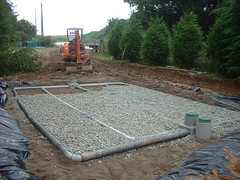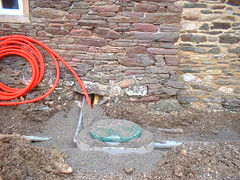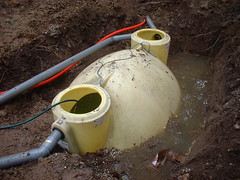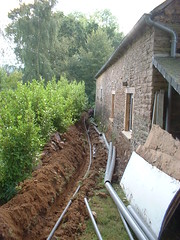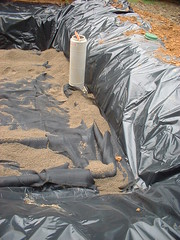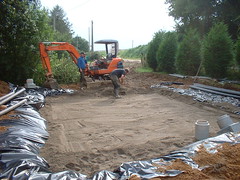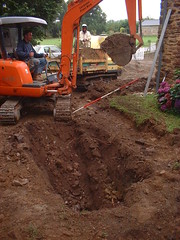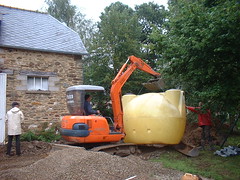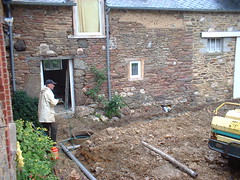New fosse - part cinq - Thursday: Completing the filterbed and pipework
Back after a few days off from Blogging (more work, groan), to the story of our new Fosse installation back in August ....
Next morning the guys laid out the series of pipework at the top of the fosse filter bed - basically a mirror image of the pipes at the bottom (although for some reason there has to be 4 pipes across the bottom and 5 across the top of the filterbed), although this time the slots in the pipework face downwards.
Liquid waste from the fosse is pumped up into the plastic green-lidded chamber nearest the digger from where it flows across the 5 horizontal pipes to the similar chamber on the opposite side, and in the mean-time drains out through the slots in the pipework into the sand, and down through the filterbed. Obviously the guys had to spend quite a bit of time ensuring all the pipework was absolutely level as otherwise the filterbed might not operate properly if the liquid from the fosse were distributed unevenly.
The second green chamber nearest the camera is the top of the inspection hatch that goes down through the filterbed to the bottom set of pipework. You can thus check that the fosse is filtering properly by unscrewing the inspection hatches - two for the top set of slotted pipes, one for the bottom set.
After the slotted pipework and inspection hatches were all levelled off, all around the top of the filter bed was filled in with coarse stone chippings - I believe to help the filtration process.
As the Nic and Bennodet were completing shovelling the chippings around the top of the filterbed and levelling it off, Tony got his mini digger out again and dug a narrow trench from the bottom inspection hatch at the back of the filter bed, round the side of the filter bed, around our large oak tree, to connect up with the trench that contained the 40mm pipe running up from the pump to the top of the filterbed (see photo of the pipework along the back of the house). Into that trench was laid a 100mm pipe to carry all the filtered water from out of the bottom of the filterbed and downhill to drain out into the drainage ditch at the side of the road beyond the end of the garden.
Finishing all the pipework off of course took quite a while, along with little things like installing a second fat trap for the kitchen in the second house and connecting up the cabling for the electric pump. The soil pipe, kitchen waste pipe and electric cable conduit (in red) all had to pass under the wall of the second house and we were quite lucky that previously I'd found a hole under the wall that the previous owners had obviously had made for just this purpose. Otherwise we would have had a devil of a job to get the pipework in as the wall is about 80cm thick and constructed from some very large pieces of stone.
Tony had arranged for an electrician to come and connect up the pump which turned out to be not much more than a 5 minute job to put a plug on the end of the cable, and then they did some tests that the pump was operating and turning off correctly.
And that was it for Thursday. The 'fosse inspector' from the water company (SAUR) had to come and inspect the installation to ensure that Tony had built everything according to the plans and regulations, but he didn't arrive so the guys were able to finish slightly early.
Categories:
Next morning the guys laid out the series of pipework at the top of the fosse filter bed - basically a mirror image of the pipes at the bottom (although for some reason there has to be 4 pipes across the bottom and 5 across the top of the filterbed), although this time the slots in the pipework face downwards.
Liquid waste from the fosse is pumped up into the plastic green-lidded chamber nearest the digger from where it flows across the 5 horizontal pipes to the similar chamber on the opposite side, and in the mean-time drains out through the slots in the pipework into the sand, and down through the filterbed. Obviously the guys had to spend quite a bit of time ensuring all the pipework was absolutely level as otherwise the filterbed might not operate properly if the liquid from the fosse were distributed unevenly.
The second green chamber nearest the camera is the top of the inspection hatch that goes down through the filterbed to the bottom set of pipework. You can thus check that the fosse is filtering properly by unscrewing the inspection hatches - two for the top set of slotted pipes, one for the bottom set.
After the slotted pipework and inspection hatches were all levelled off, all around the top of the filter bed was filled in with coarse stone chippings - I believe to help the filtration process.
As the Nic and Bennodet were completing shovelling the chippings around the top of the filterbed and levelling it off, Tony got his mini digger out again and dug a narrow trench from the bottom inspection hatch at the back of the filter bed, round the side of the filter bed, around our large oak tree, to connect up with the trench that contained the 40mm pipe running up from the pump to the top of the filterbed (see photo of the pipework along the back of the house). Into that trench was laid a 100mm pipe to carry all the filtered water from out of the bottom of the filterbed and downhill to drain out into the drainage ditch at the side of the road beyond the end of the garden.
Finishing all the pipework off of course took quite a while, along with little things like installing a second fat trap for the kitchen in the second house and connecting up the cabling for the electric pump. The soil pipe, kitchen waste pipe and electric cable conduit (in red) all had to pass under the wall of the second house and we were quite lucky that previously I'd found a hole under the wall that the previous owners had obviously had made for just this purpose. Otherwise we would have had a devil of a job to get the pipework in as the wall is about 80cm thick and constructed from some very large pieces of stone.
Tony had arranged for an electrician to come and connect up the pump which turned out to be not much more than a 5 minute job to put a plug on the end of the cable, and then they did some tests that the pump was operating and turning off correctly.
And that was it for Thursday. The 'fosse inspector' from the water company (SAUR) had to come and inspect the installation to ensure that Tony had built everything according to the plans and regulations, but he didn't arrive so the guys were able to finish slightly early.
Categories:
Labels: Gite, Renovations
